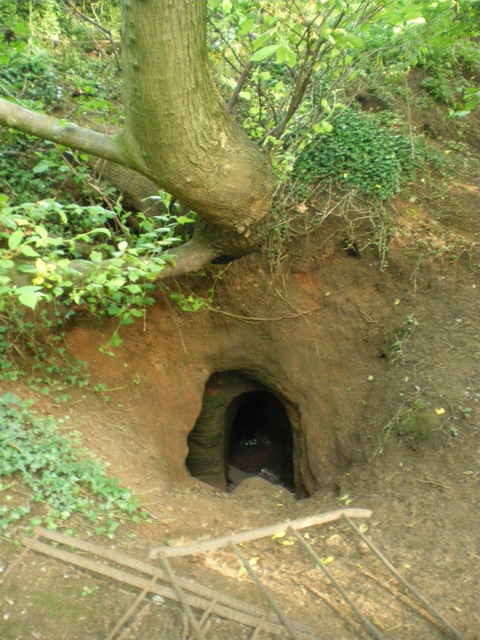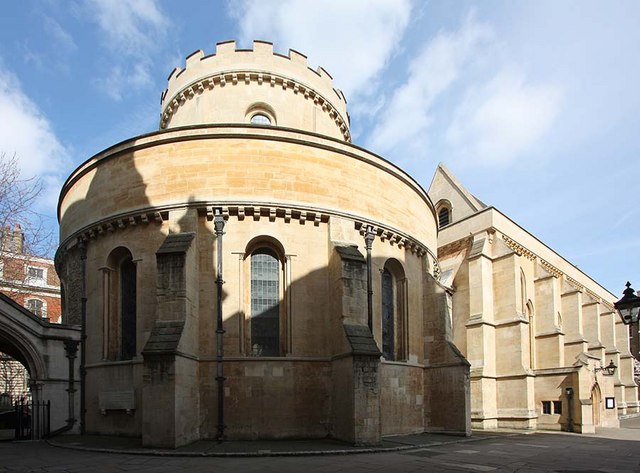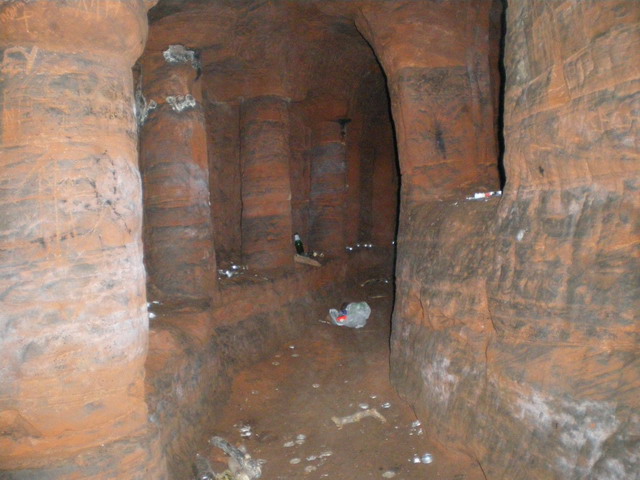I don’t know about you but sometimes when I am walking in the country and come across small holes, I wonder what might be down there. Maybe the home of foxes, rabbits or badgers but I must admit I never imagined that any of them might be hiding such a secret as one such hole in Shropshire.

Recently a photographer stuck his head down this hole and discovered a long forgotten world just a metre (3 feet) under the surface. An underground labyrinth of rough-hewn sandstone known as Caynton Caves, it is claimed, that a persecuted group of warrior monks, the Knights Templar, engaged in covert religious practices over 700 years ago.
These days the Knights Templar are mostly long forgotten but for centuries they were an unmatched force both militarily and economically so what could make the most powerful supranational organisation in the western world end up conducting their surfaces covertly?

The Knights Templar were a unique combination of knight and monk, a holy militia that sprang up in the 12th century. The full name of the order was the Poor Fellow Soldiers of Christ and of the Temple of Solomon due to the fact that their quarters in Jerusalem were next to the location of the old temple.
Their founder was a nobleman from the Champagne region, Hugh de Payens, who, in Jerusalem in 1119 nominated eight of his companions to safeguard pilgrims visiting the Holy Land from attacks by robbers and pirates, mostly in what were Islamic lands.
In 1129, the Knights were officially recognised by the Pope. They then followed religious rules, with vows of poverty, chastity and obedience — and each man pledged himself ready to die for his faith. They also adopted their distinctive uniform, a white mantle with a red cross, rather similar to the flag of England.
Together with the Knights Hospitallers, who looked after sick pilgrims, the Knights Templar became the permanent defenders of the Latin settlements in the Middle East, increasingly endowed with castles and fiefs. and by 1180, there were some 600 knights in Jerusalem, Tripoli and Antioch.
Over time, the Knights evolved into a chivalric order of warrior monks who fought with distinction in the Crusades. In fact they weren’t just any knight but in fact became widely respected for their bravery in battle against Muslims. Even more incredible however is how they developed a knack to accumulate unimaginable amounts of wealth as they became in all but name, a private bank.
A pilgrim, afraid of being robbed on his hazardous trip to the Middle East, would leave a cash deposit at Temple Church in the City of London — the English headquarters of the Knights Templar, which was consecrated in 1185 and still stands today. He would then carry a letter of credit, like travellers’ cheques, and in Jerusalem he would be able to withdraw his funds.

It is said that their influence on modern banking is their most lasting legacy. They were nothing if not meticulous and absolutely full of integrity. In fact the phrase ‘My word is my bond is’, in fact, a phrase borrowed from the Templars. If you deposited money with the Templars then you could rest assured you could regain it thought similarly if you were to take out a loan then there would be no chance of escaping repayments.
By the end of the 12th century there were thousands of Knights Templar, who accumulated considerable land, castles and spoils taken in battle.
This wealth was ostensibly for financing the Holy War, but it made them richer than the kings and princes who borrowed from them. They even bankrolled Henry II on his crusades.
When King Henry III of England purchased the private island of Oleron off the coast of France, the Templars facilitated the transaction and he paid them £200 each year for 5 years. £200 in those days was equal to £500,000 today.

In the 1200s, the Crown Jewels were kept at the Temple as security on a loan, with the Templars operating as a high-end pawnbroker. At one time, there were 4,000 civil servants managing their estates from their Paris HQ.
They were trusted, incorruptible — and dangerously powerful. But it was their challenge to Church and state that sowed the seeds of their downfall. In particular the poor King Philip IV of France who had lost a countless fortune fighting and losing wars against England. He needed a way out and after befriending the Pope, he hatched one of the most dastardly plans in history.
With debts to the Templars from which they would not release him, on Friday October 13th 1307, Philip IV of France with collaboration with Pope Clement V, lured Jacques de Molay, the Grand Master of the Order, to Paris, where he was seized and thrown into prison. What followed was the persecution of the Order, with thousands of Knights imprisoned, tortured or slaughtered.
Their ‘trial’ was a farce. The Templars were charged with heresy, worshiping false idols and other crimes against the church. Many of them were tortured until they ‘confessed’ to their crimes. Refusing to capitulate, Jacques DeMolay would not confess and Philip ordered him burned at the stake. In 2007 the Vatican issued a proclamation declaring the Templars innocent of their alleged crimes.
Some were burned at the stake, accused of sexually deviant practices and obscene ceremonies of initiation that included denying Christ and spitting or trampling on the Cross.
Many of these lurid accusations — made by two Templars of dubious character against the Order in their trial depositions — were never substantiated. Of course it is likely that the charges were all trumped up and as is the case now with secret organisations, outsiders become suspicious and aggressive towards them, often for no real reason at all. In reality the Knights services and organisation weren’t too different from churches today. It was the fact that they were loyal to their Oath of Allegiance above their Monarchs and even the Pope that was unacceptably dangerous.
The Order’s properties were transferred to their rivals, the Knights Hospitallers, an Order that survives as the Knights of St John, based in Malta.
And what of the Knights Templar in England after the collapse of the Order in Europe?
If they were driven into caves, such as those in Shropshire, it can only have been for a short time. Whilst the leaders were heavily persecuted and dealt with in sham trials, the majority were soon able to pursue their beliefs with other religious orders.
You can watch the video below to see just what lies beneath the surface in the Caynton Caves.
Ah yes, if one became too successful…invited envy….and enmity….and eventual persecution. Today the same can be done, via legal means of course, but the same instruments cloaked in a better looking sheath.
LikeLiked by 1 person
Yes it’s true. I always think it is strange how in the modern culture we are all told to be in business and to get as rich and powerful as possible but then if a company gets too big and has a monopoly then often it is forcibly broken down into smaller organisations!
LikeLiked by 1 person
Heheh…perhaps one can say that the big boys (wink) don’t like to see another one grow too large to rival them.
LikeLiked by 1 person
I Think I read an article about these caves just a week or so ago, they sound interesting, but that article said that there is some thought that they were created in the Victorian times.
I prefer thinking that they are older, but I was wondering if you could point me to any other articles on these cave? I’m very interested in learning more about them.
Thanks.
LikeLiked by 1 person
I prefer to think they are older too but agree it is more likely they are perhaps 18th century. It wasn’t a totally uncommon thing to do in those days to make such caves whether for religious services or for cults or simply just hedonistic parties. I used to work just a few miles from this place http://www.hellfirecaves.co.uk Here is a local newspaper report on the Caynton Caves http://www.birminghammail.co.uk/news/midlands-news/pictures-mysterious-knights-templar-caynton-229955 Here is a national report with some incredible photos that I didn’t think I should use on my blog!! http://www.dailymail.co.uk/news/article-4289774/Secret-underground-world-Knights-Templar-Shropshire.html and more serious article at http://www.history.com/news/is-this-a-new-templar-temple It should be said that Historic England which is a quasi governmental research and preservation body don’t believe that the Templar story is the most likely.
LikeLiked by 1 person
Thank you! I’m looking forward to learning even more about these caves!
LikeLiked by 1 person
The templars have also facilitated a whole industry in modern religious fiction almost single-handedly! 😄 I have lost count of the number of novels I have read that seem to implicate them either in religious conspiracies or cover-ups…most of them, in hindsight, really quite poor.
LikeLiked by 1 person
It is bizarre how out of dozens or even hundreds of religious and chivalrous Orders, these chaps have found themselves to be all over the place in the modern media. It can only be due their sudden demise at the hands of the King and the Pope that gives an aura that there must be a conspiracy rather than the very human story of greed and envy on behalf of the French King. I’m much more interested in the case of the Ark Of The Covenant in Ethiopia which at least on the surface has a very interesting history.
LikeLiked by 1 person
Is Indiana Jones involved in that one at all? 😄 Seriously though, I will look forward to the piece on that.
LikeLiked by 1 person
Ha ha! I never considered doing a blog on this as I assumed it was common knowledge but apparently not having asked a few people just now. Indy isn’t in it but really should be. Interestingly whereas many other countries and religious groups deny anything supernatural, the Ethiopian Church is quite open about there Holy relic, they just don’t let the public ever see it!
LikeLike
You should write a script for Mr Spielberg…🙂
LikeLike